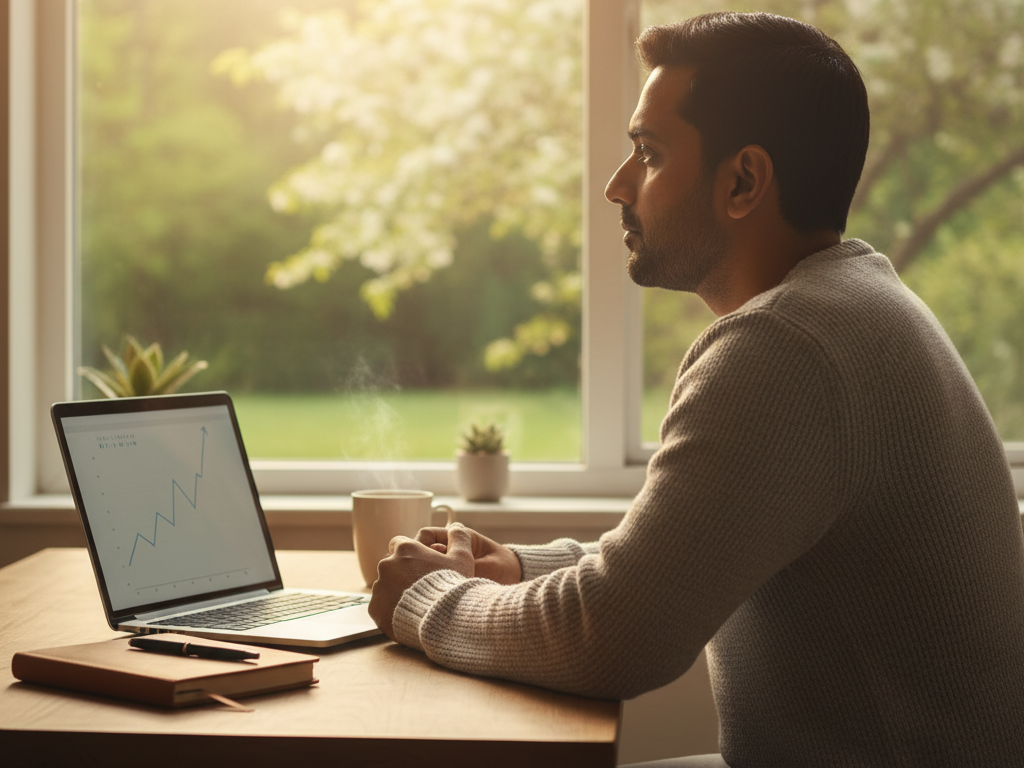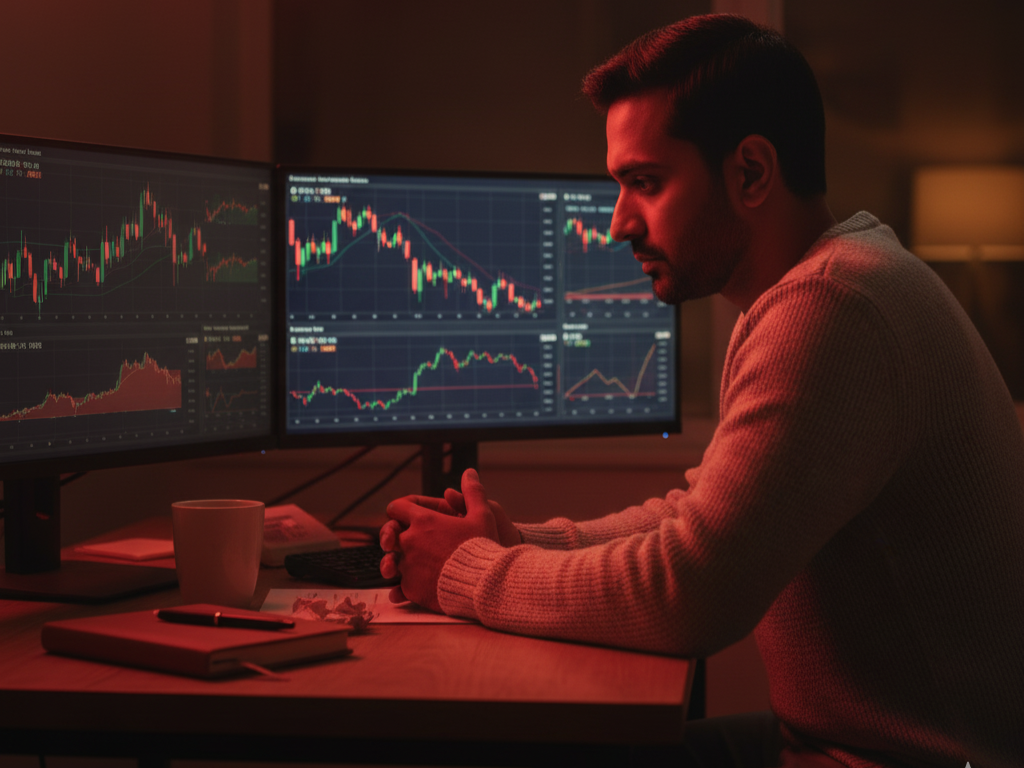The Day I Stopped Chasing Quick Profits and Found Real Freedom: A Quiet Realisation That Rewired My Entire Relationship with Money…
If you’ve ever felt anxious, obsessed, or ashamed about your trading habits, I get it.
I’ve been there.
I was you.
I remember those days clearly. Staring at charts, staring at my P/L screen for hours, waiting to see a miracle.
I’d watch videos of people turning ₹10,000 into ₹1 lakh in a week and think, “Maybe this time, I’ll do it too.”
That tiny voice was convincing. And it took me a very long time to realize that I was no more than a gambler, disguising myself as a retail trader.
But it wasn’t just about money anymore; it became about proving something to myself.
I could think of nothing else. I learned everything I possibly could.
Yet, all it gave me in return was stress, sleepless nights, and disappointment so deep that I doubted myself every single day for years.

Why We Get Stuck
For the longest time, I thought I lacked discipline or the right knowledge.
But I was wrong.
What I really lacked was understanding—not of the market, but of myself, my emotions, and the invisible patterns that drove my actions.
Trading wasn’t just about numbers. It was about psychology.
And here’s what I learned.
(These are reflections from years of journaling, pages filled with honesty, frustration, and slow realisations.)
1. We Want Fast Results
Our brains crave quick rewards. Waiting for something long-term feels boring.
Almost none of us want to follow the strategy of “invest and forget it for five years.”
That’s why we jump from one trade to another—what we proudly call intraday trading—hoping for that “big hit” every day.
But I realised that chasing fast profits usually leads to faster losses.
I realised that I wasn’t investing in the market. I was gambling with emotions.
2. We Get Addicted to the High
Every time I saw a green candle or a profit, it felt electric, even if it was just ₹500. That small win gave me a dopamine rush, and I wanted more; even when logic told me to stop, emotions told me to continue.
Soon, it wasn’t about strategy anymore. It was about chasing that same feeling, like a gambler chasing luck.
3. We Compare Ourselves
Social media made it worse.
I’d scroll through posts of people showing screenshots of huge gains or memes glorifying day trading.
They looked smart, confident, successful.
And there I was, waiting for my losses to recover, doubting myself every passing second.
Feeling behind. Feeling hopeless.
That pressure made me take trades I wasn’t ready for. It didn’t make sense to me, but I didn’t want to feel like a loser.
I risked my father’s hard-earned money, and I felt deeply ashamed of it.
4. We Think We’re in Control
There was a time I believed I could outsmart the market.
One chart, one signal, one trade, and I’d win a jackpot. But the market doesn’t care about confidence.
It doesn’t reward ego.
It rewards patience; sometimes, nothing at all.
And when I finally understood that, it humbled me in the best way possible.
The Wake-Up Call
One day, after another big loss, my consciousness was filled with one simple question:
“Until when?”
Honestly, I didn’t have an answer.
I wasn’t growing wealth. I was growing anxiety. I was working hard only to lose more.
And that day, with all the courage I had left, I finally stopped.
Years of effort, patience, and longing for profits came to an end.
I felt broken from the inside and cried for days. The guilt of failure was too heavy for my younger self to carry.
The Hard Truth I Needed to Hear
Before I tell you how everything started to change, I need to share something I wish someone had told me earlier:
“If you’re still struggling to make ends meet, trading is not the way out.”
I know it sounds harsh, but it’s the truth that I realized very slowly.
When you’re low on funds, every rupee feels like oxygen. And when that rupee is at risk, emotions take over. Logic disappears.
The truth is, 95% of us who face losses aren’t really trading; we’re merely gambling to survive.
And survival and strategy can’t coexist for long.
So, I learned to step back.
Not because I failed, but because I wanted to rebuild from a stronger place.
I focused on earning, saving, and stabilizing first—through consistent income, budgeting, and small disciplined habits.
When your foundation is strong, the market stops feeling like a storm.
It becomes an opportunity.
Trading Should Be a Choice, Not an Escape
If you’re trading just to fix your finances, please pause.
Focus instead on fixing the system around your finances.
Start a side hustle.
Learn a skill.
Build your emergency fund.
Understand how money really grows. Slowly, silently, and surely.
Then, when you’re ready, when losses don’t shake your peace anymore – the market will still be there, waiting for you.
But this time, you’ll be the calm one in the storm.
How I Changed: From Chasing Profits to Building Purpose
I realized that financial recovery requires emotional distance.
When I went through consecutive losses, my brain began linking money with pain, guilt, and fear.
If I had tried to trade again too soon, that residue would have followed me, clouding my judgment.
I knew I needed space.
A career pivot.
A new skill.
A different source of income. Something that would restore my balance before I re-entered the market.
Because the truth is, “you can’t heal in the same environment that broke you.”
You can’t unlearn fear while staring at a red chart.
My mind needed a neutral space. A job, freelancing, business, or any stable pursuit that could bring back dignity and structure to my life.
And after a few days of rest and looking for alternatives, here’s what comforted me most: the knowledge I gained wasn’t wasted. It was repurposed.
Trading had taught me priceless lessons – risk management, patience, probability, psychology, and pattern recognition. I could apply these skills anywhere: entrepreneurship, finance, content creation, project management, or even something as small as personal budgeting.
Fast Forward
Rebuilding a new career slowly restored my self-worth.
When my income started coming from stability instead of volatility, I began to trust myself again.
That’s when real healing began—when money stopped being a gamble and became a reward for patience, structure, and growth.
1. I Built Long-Term Pillars for Wealth
At my lowest point, I realized something both harsh and liberating:
Trading is for those who can afford to lose.
If I was still building my foundation, it wasn’t the right battlefield.
So I paused—not as a failure, but as a strategic retreat.
I began rebuilding:
- Started SIPs and index funds with small, consistent investments.
- Created a contingency fund so I’d never trade out of desperation again.
- Learned asset allocation—balancing equity, debt, and liquidity.
- Focused on increasing income, not forcing profits.
It was slower, but it was real.
For the first time, my financial growth had roots.
2. I Turned Patience into a Strategy
Earlier, patience felt like doing nothing. It made me restless.
But slowly, I started to see it as discipline in motion. I got myself a job and started a side hustle, parallelly.
I stopped checking my portfolio every hour.
I allowed time to do its work. I let it compound quietly.
The calm that followed was worth more than any trade I had ever won.
As a friend, really want to share this:
“The peace and joy that comes from slow, steady growth is stronger than the anxiety of any risky trade.”

3. I Stopped Thinking Like a Trader and Started Thinking Like a Manager
I realized that market didn’t need my emotions, it needed my systems.
So I built one.
I started managing my finances the way a company manages its cash flow, with budgets, reviews, and clear allocation. Honestly, I didn’t actually have any experience of how a company handles its funds, but learned it keeping in mind that I’m running my own company.
Every rupee had a purpose: some for growth, some for safety, some for opportunity.
I wasn’t trying to double my money anymore. Because a company never does that.
I was managing it like a business asset, with detachment and discipline.
That single shift- from chasing to managing – changed everything for me.
4. I Created a Rule-Based Framework
No more gut-feeling trades.
No more impulsive “revenge” entries.
I built a personal rulebook – my Financial Operating System – and followed it faithfully.
- Risk per trade: never more than 1–2% of capital.
- Stop-losses and profit targets: decided before the trade, not during.
- Weekly reviews: focused on behavior, not just numbers.
Gradually, the structure my mind replaced the chaos in my heart.
For the first time, I felt in control of myself, not the market.
5. I Measured Growth Beyond Money
I started journaling again, this time not just profits and losses, but emotions: fear, greed, pride, guilt.
And soon, I began to see patterns in myself more than in charts.
That’s when I understood something profound:
The market was never my opponent. It was my mirror. And I’m confidant that you’ll realize it sooner or later as well.
The moment I stopped fighting it and started mastering myself, my life changed.
You’re Not Alone
If you see yourself in my story, know this:
You’re not weak.
You’re not foolish.
You’re human.
We all crave control. We all want to win.
But real wealth isn’t loud.
It doesn’t show off.
It grows slowly – quietly – like peace of mind.
So take a breath.
Step back.
You’re not behind. You’re just beginning.
And if that little voice whispers, “Maybe this time,”
smile at it and remind yourself:
“I’m not chasing anymore. I’m growing.”
Final Thought
Your journey in trading doesn’t need to be perfect.
It just needs to be honest.
The moment you stop running after quick profits and start understanding yourself, that’s the moment you truly start winning.
If you’ve read this till the end, thank you❤️
With love,
Chitraansh





Добро пожаловать! Готовлю к поездку в Испанию и планирую узнать больше о центральных местах и курортах страны. Особенно интересуют такие зоны, как Путь Святого Иакова (Camino de Santiago), Тейде и Канарские острова, вместе с Ла Пальма с её вулканом. Если кто-то не так давно был в Барселоне, Малаге или Аликанте, сообщите, пожалуйста, опытом — где предпочтительно остановиться и что изучить.
Помимо этого ищу информацию по городам наподобие Сарагосы, Кордовы и Ронды, а еще интересуюсь, где локализована Ибица и как достичь до острова Тенерифе на карте. Было бы замечательно узнать про живописные места с архитектурой Гауди и собором Святого Семейства. Для тех, кто хочет глубже исследовать тему, есть практичный ресурс эль камино машина с обстоятельными маршрутами и советами. Буду признателен за любые советы и рекомендации!